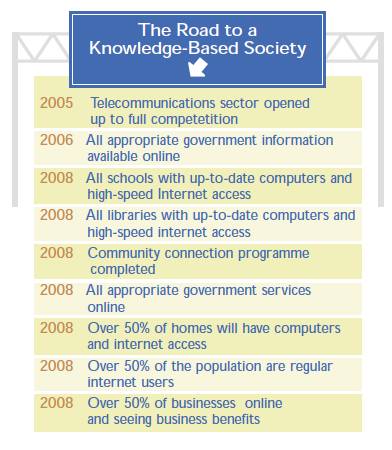

| Introduction Network Access Network Learning Network Society Network Economy Network Policy Off Shoring References Authors |

Trinidad and
Tobago Ministry of Education set forth an actions plan called Vision2020, where
the primary goal is to create an educational system for students to be
confident, creative and productive users of the Information and Communication
Technologies (ICT) as early as possible for a lifelong learning.
In 1999,
Inter-American Development Bank approved a US$100 million loan to the
Government of Trinidad and Tobago for the
Secondary Education Modernization Program. A comprehensive
program that addresses the following:
School Access
to ICT (Stage 4)
School Access to
the ICT started back in 1984 when four Macintosh Computers where place in
thirty-five secondary schools. Between
1998 and 1999, there were 1120 additional computers placed into the educational
systems. An ICT refresh programs called
Fast Forward launched in 2006, it distributed around 7000 computers just to the
primary schools, to update and replace non-functional and maintenance
challenged computers, ensuring that all schools have latest equipment.
All government
sponsored Secondary schools under the fast forward initiative, received
thirty-four computers each and additionally the secondary schools were provided
selected number of Computers on carts with the wireless connectivity for use
within the class room environment. All
secondary schools have dial-up and ADSL access for broadband connectively and
some are pushing into fiber networks.
As of today, the different levels of
education from primary, secondary, and tertiary all have access to the multiple
computers; despite that the current levels of ICT access and use are not
adequate. Service contracts and warranties
are not being completed fast enough to continue daily usage of these computers,
causing shortage and reduction in the use of ICT in schools. Most ICT resources were funded by the oil
companies like Amoco and Shell in collaboration with the Ministry of Education.
The illustration below lists the number of government schools in the Trinidad
and Tobago, median enrollment in these schools, and their ICT profile. 
Enhancing Education with ICT (Stage3, approaching stage 4)
Driving this area
of focus from its current phase of stage 3, quickly pushing its way to stage 4
with the education enhancements with the use of ICT, are incentives like possible increases to salary and free tuitions
for the teachers to take the ICT professional development programs. Between years of 1998 and 2001, because of
the high demand for ICT classes and teachers who lacked proper computer skills
to include ICT in their courses, the Ministry of Education trained around 3000 teachers,
now more than half of the secondary teachers have acquired the ICT skills.
At the current level of stage 3, In-service
teachers are given an opportunity which is sponsored by the government to take
part in the full or part training in ICT using their class rooms. Teachers are trained to use the technology
in classroom and in developing multimedia learning resources for their courses
to incorporate e-learning activities for the students.
There are some
issues with reaching stage 4 because of the lack tools like digital cameras,
multimedia projectors, and some cases internet connectively. Teachers are not involved in the ICT
implementation in schools. Outdated functional resources are replaced instead
of allowing other teachers and students to utilize them for other subjects
beyond the computer science and information technology. Developing
the ICT Workforce (Stage 4)
Trinidad and
Tobago reached a stage 4 – in developing the ICT workforce. Teachers are able to purchase home computers
using government subsidy for additional training. Students are able to participate in distance
learning courses. The Ministry of Education
is putting particular emphasis on building
an export-oriented software and ICT services industry and wants to attract
local and multinational ICT companies by planning to build a science and
technology park.
The University of Trinidad and Tobago and University of the West Indies Distance Education Centre both have opened satellite location
campuses around the island. University of the West Indies Distance Education Centre having six locations, were each campus
offers an online admissions process for the ICT training programs. In 2006, The Ministry of Education, opened
the National Open School of Trinidad
and Tobago providing distance learning which includes the ICT skills development
and certification , additionally there are also low quality ICT training
institutes that have open up to deal with increasing demand for ICT education.
Following illustration shows the road to a knowledge-based society taken
by the Trinidad and Tobago. 
|